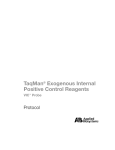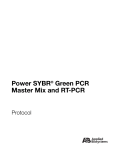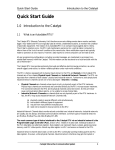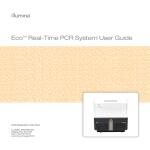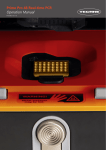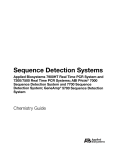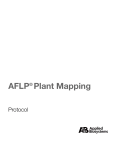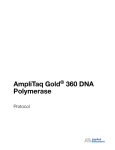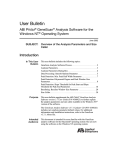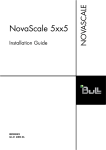Download TaqMan® Allelic Discrimination Demonstration Kit
Transcript
TaqMan Allelic Discrimination ® Demonstration Kit Protocol © Copyright 2008, 2010 Applied Biosystems. All rights reserved. For Research Use Only. Not for use in diagnostic procedures. Information in this document is subject to change without notice. Applied Biosystems assumes no responsibility for any errors that may appear in this document. APPLIED BIOSYSTEMS DISCLAIMS ALL WARRANTIES WITH RESPECT TO THIS DOCUMENT, EXPRESSED OR IMPLIED, INCLUDING BUT NOT LIMITED TO THOSE OF MERCHANTABILITY OR FITNESS FOR A PARTICULAR PURPOSE. IN NO EVENT SHALL APPLIED BIOSYSTEMS BE LIABLE, WHETHER IN CONTRACT, TORT, WARRANTY, OR UNDER ANY STATUTE OR ON ANY OTHER BASIS FOR SPECIAL, INCIDENTAL, INDIRECT, PUNITIVE, MULTIPLE OR CONSEQUENTIAL DAMAGES IN CONNECTION WITH OR ARISING FROM THIS DOCUMENT, INCLUDING BUT NOT LIMITED TO THE USE THEREOF. Notice to Purchaser: Limited License Use of this TaqMan® Allelic Discrimination Demonstration Kit (P/N 4303263) is covered by US patent claims and patent claims outside the US. The purchase of this product includes a limited, nontransferable immunity from suit under the foregoing patent claims for using only this amount of product for the purchaser’s own internal research. No right under any other patent claim (such as apparatus or system claims for real-time PCR) and no right to perform commercial services of any kind, including without limitation reporting the results of purchaser's activities for a fee or other commercial consideration, is conveyed expressly, by implication, or by estoppel. This product is for research use only. Diagnostic uses under Roche patents require a separate license from Roche. Further information on purchasing licenses may be obtained from the Director of Licensing, Applied Biosystems, 850 Lincoln Centre Drive, Foster City, California 94404, USA. Probes labeled at the 5’ and 3’ end, and their use in the 5’ nuclease assay, are covered by patents, issued and pending, owned by Applied Biosystems. TRADEMARKS Applied Biosystems, AB (Design), ABI PRISM and MicroAmp are registered trademarks and ABI, and Primer Express are trademarks of Applied Biosystems or its subsidiaries in the U.S. and/or certain other countries. AmpErase, AmpliTaq Gold, GeneAmp, and TaqMan are registered trademarks of Roche Molecular Systems, Inc. All other trademarks are the sole property of their respective owners. Contents Introduction . . . . . . . . . . . . . . . . . . . . . . . . . . . . . . . . . . . . . . . . . . . . . . . . . . . .1 Overview. . . . . . . . . . . . . . . . . . . . . . . . . . . . . . . . . . . . . . . . . . . . . . . . .1 5´ Nuclease Assay . . . . . . . . . . . . . . . . . . . . . . . . . . . . . . . . . . . . . . . . . .1 Sequence Detection. . . . . . . . . . . . . . . . . . . . . . . . . . . . . . . . . . . . . . . . .3 Allelic Discrimination. . . . . . . . . . . . . . . . . . . . . . . . . . . . . . . . . . . . . . .3 System Performance Guarantee . . . . . . . . . . . . . . . . . . . . . . . . . . . . . . .3 Demonstrated Performance. . . . . . . . . . . . . . . . . . . . . . . . . . . . . . . . . . .3 Materials and Equipment. . . . . . . . . . . . . . . . . . . . . . . . . . . . . . . . . . . . . . . . . .4 Kit Contents . . . . . . . . . . . . . . . . . . . . . . . . . . . . . . . . . . . . . . . . . . . . . .4 Storage and Stability . . . . . . . . . . . . . . . . . . . . . . . . . . . . . . . . . . . . . . . .4 Instruments Required . . . . . . . . . . . . . . . . . . . . . . . . . . . . . . . . . . . . . . .5 User-Supplied Materials . . . . . . . . . . . . . . . . . . . . . . . . . . . . . . . . . . . . .5 Technical Support . . . . . . . . . . . . . . . . . . . . . . . . . . . . . . . . . . . . . . . . . . . . . . .6 To Reach Us On the Web . . . . . . . . . . . . . . . . . . . . . . . . . . . . . . . . . . . .6 Hours for Telephone Technical Support . . . . . . . . . . . . . . . . . . . . . . . . .6 To Reach Us by Telephone or Fax in North America . . . . . . . . . . . . . . .6 jDocuments on Demand . . . . . . . . . . . . . . . . . . . . . . . . . . . . . . . . . . . . .9 To Reach Us by E-Mail. . . . . . . . . . . . . . . . . . . . . . . . . . . . . . . . . . . . . .6 Regional Offices Sales and Service . . . . . . . . . . . . . . . . . . . . . . . . . . . .7 Preventing Contamination . . . . . . . . . . . . . . . . . . . . . . . . . . . . . . . . . . . . . . . .13 Overview. . . . . . . . . . . . . . . . . . . . . . . . . . . . . . . . . . . . . . . . . . . . . . . .13 Prevention of PCR Product Carryover . . . . . . . . . . . . . . . . . . . . . . . . .13 General PCR Practices . . . . . . . . . . . . . . . . . . . . . . . . . . . . . . . . . . . . .14 Fluorescent Contaminants. . . . . . . . . . . . . . . . . . . . . . . . . . . . . . . . . . .14 Preparing Control Reactions and Control DNA Samples . . . . . . . . . . . . . . . .15 Overview. . . . . . . . . . . . . . . . . . . . . . . . . . . . . . . . . . . . . . . . . . . . . . . .15 Prepare Controls and Unknowns. . . . . . . . . . . . . . . . . . . . . . . . . . . . . .16 i PCR Amplification . . . . . . . . . . . . . . . . . . . . . . . . . . . . . . . . . . . . . . . . . . . . . 18 Thermal Cycling Parameters . . . . . . . . . . . . . . . . . . . . . . . . . . . . . . . . 18 Real Time Run on the ABI PRISM 7700. . . . . . . . . . . . . . . . . . . . . . . . 19 Performing PCR on the GeneAmp 9600 and 9700 . . . . . . . . . . . . . . . 19 Allelic Discrimination on the ABI PRISM 7700 and 7200 . . . . . . . . . . . . . . . 20 Overview . . . . . . . . . . . . . . . . . . . . . . . . . . . . . . . . . . . . . . . . . . . . . . . 20 Analysis on the ABI PRISM 7700 or 7200 . . . . . . . . . . . . . . . . . . . . . . 20 Allelic Discrimination on the LS-50B . . . . . . . . . . . . . . . . . . . . . . . . . . . . . . 22 LS-50B Settings . . . . . . . . . . . . . . . . . . . . . . . . . . . . . . . . . . . . . . . . . . 22 Measure Fluorescence . . . . . . . . . . . . . . . . . . . . . . . . . . . . . . . . . . . . . 22 Appendix A. Guidelines for Custom Applications . . . . . . . . . . . . . . . . . . . . 24 Nine-Step Program. . . . . . . . . . . . . . . . . . . . . . . . . . . . . . . . . . . . . . . . 24 Identify Target Sequence . . . . . . . . . . . . . . . . . . . . . . . . . . . . . . . . . . . 24 Design TaqMan Probe . . . . . . . . . . . . . . . . . . . . . . . . . . . . . . . . . . . . . 24 Design Primers . . . . . . . . . . . . . . . . . . . . . . . . . . . . . . . . . . . . . . . . . . . 25 Order Reagents. . . . . . . . . . . . . . . . . . . . . . . . . . . . . . . . . . . . . . . . . . . 25 Quantitate Probes and Primers . . . . . . . . . . . . . . . . . . . . . . . . . . . . . . . 25 Optimize Primer Concentrations . . . . . . . . . . . . . . . . . . . . . . . . . . . . . 26 Optimize Probe Concentrations . . . . . . . . . . . . . . . . . . . . . . . . . . . . . . 29 Set Up and Run an Allelic Discrimination Plate . . . . . . . . . . . . . . . . . 34 Appendix B. Real Time Detection on the ABI PRISM 7700 . . . . . . . . . . . . . 40 Threshold Cycle . . . . . . . . . . . . . . . . . . . . . . . . . . . . . . . . . . . . . . . . . . 40 Appendix C. References . . . . . . . . . . . . . . . . . . . . . . . . . . . . . . . . . . . . . . . . 41 ii Introduction Overview The TaqMan® Allelic Discrimination Demonstration Kit is a model assay to show the allelic discrimination capabilities of the Applied Biosystems Sequence Detection Systems. It has been optimized for use with TaqMan Universal PCR Master Mix (P/N 4304437). Direct detection of polymerase chain reaction (PCR) product with no downstream processing is accomplished within minutes of PCR completion by measuring the increase in fluorescence of dye-labeled DNA probes. This method permits the analysis of thousands of samples per day with high sample-to-sample reproducibility. 5´ Nuclease Assay The TaqMan Allelic Discrimination Demonstration Kit employs a probe technology that exploits the 5´-3´ nuclease activity of AmpliTaq Gold® DNA Polymerase to allow direct detection of the PCR product by the release of a fluorescent reporter as a result of PCR. This PCR system is optimized for yield. AmpErase® UNG is required for the prevention of PCR product carryover (Longo et al., 1990). For more information on the 5´ nuclease assay, refer to Lawyer et al., 1989, Holland et al., 1991, and Lyamichev et al., 1993. Two TaqMan probes are used in this allelic discrimination assay, one probe for each allele in a two-allele system. Each probe consists of an oligonucleotide with a 5´-reporter dye and a 3´-quencher dye. TET (6-carboxy-4,7,2´,7´-tetrachlorofluorescein) is covalently linked to the 5´ end of the probe for the detection of Allele 1. FAM (6-carboxyfluorescein) is covalently linked to the 5´ end of the probe for the detection of Allele 2. Each of the reporters is quenched by TAMRA (6-carboxy-N,N,N´,N´-tetramethylrhodamine) attached via a linker arm located at the 3´ end of each probe. When the probe is intact, the proximity of the reporter dye to the quencher dye results in suppression of the reporter fluorescence, primarily by Förster-type energy transfer (Förster, 1948; Lakowicz, 1983). During PCR, forward and reverse primers hybridize to a specific sequence of the target DNA. The TaqMan probe hybridizes to a target sequence within the PCR product. The AmpliTaq Gold enzyme cleaves the TaqMan probe with its 5´–3´ nuclease activity. The reporter dye and quencher dye are separated upon cleavage, resulting in increased fluorescence of the reporter (Figure 1 on page 2). The 3´ end of the TaqMan probe is blocked to prevent extension of the probe during PCR. 1 Figure 1 The fork-like-structure-dependent, polymerization-associated, 5´–3´ nuclease activity of AmpliTaq Gold DNA Polymerase during one extension phase of PCR (Lyamichev et al., 1993) This process occurs in every cycle and does not interfere with the exponential accumulation of product. The separation of the reporter dyes from the quencher dye results in increase in fluorescence for each of the FAM and TET reporters. The increase in fluorescence is measured, and is a direct consequence of target amplification during PCR. Both primer and probe must hybridize to their targets for amplification and cleavage to occur. The fluorescence signals are generated only if the target sequences for the probes are amplified during PCR. Because of these requirements, non-specific amplification is not detected. For information on release of a fluorescent reporter during the PCR, refer to Lee et al., 1993, and Livak et al., 1995. continued on next page 2 Sequence The Sequence Detection Systems from Applied Biosystems are used to Detection measure the increase of reporter fluorescence following PCR. Reporter signals are normalized to the emission of a passive reference: Rn (AL1) Rn (AL2) = = Emission Intensity of Allele 1 Reporter Emission Intensity of Passive Reference Emission Intensity of Allele 2 Reporter Emission Intensity of Passive Reference These parameters are used in the Allelic Discrimination analysis software described on pages 19–21. Allelic The TaqMan Allelic Discrimination Demonstration Kit illustrates Discrimination discrimination between the alleles of a two-allele system. It contains enough PCR reagents for up to 200 reactions of 50 µL each. During amplification, the Plasmid Allele 1 and Plasmid Allele 2 standards supplied with the kit generate reporter fluorescent signals such that allele calls may be made on unknown samples. Allele 1 and Allele 2 probes supplied in the Probe and Primer Mix with the TaqMan Allelic Discrimination Demonstration Kit can be used with the specific Genomic Control DNA included in the kit. Custom probes must be designed for detection of any other templates. See Appendix A, "Guidelines for Custom Applications," on page 23. System Using the Genomic Control DNA and protocol for the TaqMan Allelic Performance Discrimination Demonstration Kit, automated allele calls will be Guarantee reported by the Sequence Detection System with a 99.7% confidence level. Demonstrated The minimum and maximum detection range is from 10–100 ng of Performance Genomic Control DNA, which is approximately 104–105 copies of a single copy gene. 3 Materials and Equipment Kit Contents The TaqMan Allelic Discrimination Demonstration Kit (P/N 4303263) has been designed to provide 200 reactions of 50 µL each. Experiments have been performed with the ABI PRISM® 7700 and ABI PRISM 7200 Sequence Detectors showing that a 25-µL final reaction volume will provide the same precision for TaqMan allelic discrimination assays. We do not recommend final reaction volumes lower than 25 µL. The contents of the TaqMan Allelic Discrimination Demonstration Kit are listed in Table 1. Table 1. Kit Components Component Volume Description TaqMan Universal PCR Master Mix 5.75 mL One bottle, sufficient for 200 reactions of 50 µL each Probe and Primer Mix 3.45 mL Two tubes, sufficient for 200 reactions of 50 µL each, containing the following: ♦ Forward primer: 5´-CAG TGG TGC CAG CTC AGC A-3´ ♦ Reverse primer: 5´-GGT GAG GCT GTG GCT GAA CA-3´ ♦ TaqMan Plasmid Allele 1 probe: 5´-TET-CCA GCA ACC AAT GAT GCC CGT T-TAMRA-3´ ♦ TaqMan Plasmid Allele 2 probe: 5´-FAM-CCA GCA AGC ACT GAT GCC TGT TC-TAMRA-3´ Plasmid Allele 1 standard 250 µL One tube (10 fg/µL), sufficient for 100 reactions Plasmid Allele 2 standard 250 µL One tube (10 fg/µL), sufficient for 100 reactions Genomic Control DNA (human) 1.0 mL Two tubes (10 ng/µL), sufficient for 200 reactions Storage and Store the TaqMan Allelic Discrimination Demonstration Kit or its Stability components at 2–6 °C. If stored under the recommended conditions, the product will maintain performance through the control date printed on the label. continued on next page 4 Instruments One of the following instrument systems in Table 2 is required. Required Table 2. Instrument Platforms for Allelic Discrimination Equipment Item Source ♦ ABI PRISM® 7700 Sequence Detector ♦ ABI PRISM® 7200 Sequence Detector and GeneAmp® PCR System 9600 or GeneAmp® PCR System 9700 in 9600 Emulation Mode Applied Biosystems (call your regional sales office for the instrument best suited your needs) ♦ TaqMan® LS-50B PCR Detection System and GeneAmp PCR System 9600 or GeneAmp PCR System 9700 in 9600 Emulation Mode User-Supplied The following items in Table 3 may be required in addition to the Materials reagents supplied in the TaqMan Allelic Discrimination Demonstration Kit. Table 3. User-supplied Materials Reagent/Equipment Item Source Deionized water or TE buffer (10 mM Tris-HCl, 1 mM EDTA, pH 8.0) Major laboratory suppliers (MLS) TaqMan Universal PCR Master Mix Applied Biosystems (P/N 4304437) MicroAmp® Optical 96-Well Reaction Plate and Optical Caps Applied Biosystems (P/N 403012) 96-Well Microplate (Portvair) Applied Biosystems (P/N L225-1692) Primer Express™ software Applied Biosystems (P/N 402089) Note The ABI PRISM 7700 and ABI PRISM 7200 Sequence Detectors use the MicroAmp Optical 96-Well Reaction Plate and MicroAmp Optical Caps. The LS-50B PCR Detection System uses the 96-Well Microplate (Portvair). 5 Technical Support To Reach Us on the Applied Biosystems web site address is: Web http://www.appliedbiosystems.com/techsupport We strongly encourage you to visit our web site for answers to frequently asked questions, and to learn more about our products. You can also order technical documents and/or an index of available documents and have them faxed or e-mailed to you through our site (see the “Documents on Demand” section below). Hours for In the United States and Canada, technical support is available at the Telephone following times. Hours Technical Support Product Chemiluminescence 9:00 a.m. to 5:00 p.m. Eastern Time LC/MS 9:00 a.m. to 5:00 p.m. Pacific Time All Other Products 5:30 a.m. to 5:00 p.m. Pacific Time See the “Regional Offices Sales and Service” section below for how to contact local service representatives outside of the United States and Canada. To Reach Us by Call Technical Support at 1-800-831-6844, and select the appropriate option Telephone or Fax (below) for support on the product of your choice at any time during the call. (To in North America open a service call for other support needs, or in case of an emergency, press 1 after dialing 1-800-831-6844.) For Support On This Product ABI PRISM ® 3700 DNA Analyzer ABI PRISM ® 3100 Genetic Analyzer DNA Synthesis 6 Dial 1-800-831-6844, and... Press FAX 8 650-638-5981 Press FAX 26 650-638-5891 Press FAX 21 650-638-5981 For Support On This Product Fluorescent DNA Sequencing Fluorescent Fragment Analysis (includes GeneScan® applications) Integrated Thermal Cyclers BioInformatics (includes BioLIMS™, BioMerge™, and SQL GT™ applications) PCR and Sequence Detection Dial 1-800-831-6844, and... Press FAX 22 650-638-5891 Press FAX 23 650-638-5891 Press FAX 24 650-638-5891 Press FAX 25 505-982-7690 Press FAX 5, or call 240-453-4613 1-800-762-4001, and press 1 for PCR, or 2 for Sequence Detection FMAT Peptide and Organic Synthesis Protein Sequencing Chemiluminescence Telephone FAX 1-800-899-5858, and press 1, then press 6 508-383-7855 Press FAX 31 650-638-5981 Press FAX 32 650-638-5981 Telephone FAX 1-800-542-2369 (U.S. only), or 781-275-8581 (Tropix) 1-781-271-0045 (Tropix) 9:00 a.m. to 5:00 p.m. ET 7 For Support On This Product LC/MS Dial 1-800-831-6844, and... Telephone FAX 1-800-952-4716 650-638-6223 9:00 a.m. to 5:00 p.m. PT 8 Documents on Free 24-hour access to Applied Biosystems technical documents, Demand including MSDSs, is available by fax or e-mail. You can access Documents on Demand through the internet or by telephone: If you want to order... through the internet Then... Use http://www.appliedbiosystems.com/techsupport You can search for documents to order using keywords. Up to five documents can be faxed or e-mailed to you by title. by phone from the United States or Canada a. Call 1-800-487-6809 from a touch-tone phone. Have your fax number ready. b. Press 1 to order an index of available documents and have it faxed to you. Each document in the index has an ID number. (Use this as your order number in step “d” below.) c. Call 1-800-487-6809 from a touch-tone phone a second time. d. Press 2 to order up to five documents and have them faxed to you. by phone from outside the United States or Canada a. Dial your international access code, then 1-858-712-0317, from a touch-tone phone. Have your complete fax number and country code ready (011 precedes the country code). b. Press 1 to order an index of available documents and have it faxed to you. Each document in the index has an ID number. (Use this as your order number in step “d” below.) c. Call 1-858-712-0317 from a touch-tone phone a second time. d. Press 2 to order up to five documents and have them faxed to you. 9 To Reach Us by Contact technical support by e-mail for help in the following product E-Mail areas. For this product area Use this e-mail address Chemiluminescence [email protected] Genetic Analysis [email protected] LC/MS [email protected] PCR and Sequence Detection [email protected] Protein Sequencing, Peptide and DNA Synthesis [email protected] Regional Offices If you are outside the United States and Canada, you should contact Sales and Service your local Applied Biosystems service representative. The Americas United States Applied Biosystems 850 Lincoln Centre Drive Foster City, California 94404 Tel: Fax: Latin America (Del.A. Obregon, Mexico) Tel:(305) 670-4350 Fax: (305) 670-4349 (650) 570-6667 (800) 345-5224 (650) 572-2743 Europe Austria (Wien) Hungary (Budapest) Tel: 43 (0)1 867 35 75 0 Fax: 43 (0)1 867 35 75 11 Tel: Fax: Belgium Tel: Fax: 10 36 (0)1 270 8398 36 (0)1 270 8288 Italy (Milano) 32 (0)2 712 5555 32 (0)2 712 5516 Tel: Fax: 39 (0)39 83891 39 (0)39 838 9492 Czech Republic and Slovakia (Praha) The Netherlands (Nieuwerkerk a/d IJssel) Tel: Fax: Tel: Fax: 420 2 61 222 164 420 2 61 222 168 31 (0)180 331400 31 (0)180 331409 Denmark (Naerum) Norway (Oslo) Tel: Fax: Tel: Fax: 45 45 58 60 00 45 45 58 60 01 47 23 12 06 05 47 23 12 05 75 Europe Finland (Espoo) Tel: Fax: 358 (0)9 251 24 250 358 (0)9 251 24 243 Poland, Lithuania, Latvia, and Estonia (Warszawa) Tel: Fax: 48 (22) 866 40 10 48 (22) 866 40 20 France (Paris) Portugal (Lisboa) Tel: Fax: Tel: Fax: 33 (0)1 69 59 85 85 33 (0)1 69 59 85 00 351 (0)22 605 33 14 351 (0)22 605 33 15 Germany (Weiterstadt) Russia (Moskva) Tel: Fax: Tel: Fax: 49 (0) 6150 101 0 49 (0) 6150 101 101 7 095 935 8888 7 095 564 8787 Spain (Tres Cantos) South Africa (Johannesburg) Tel: Fax: Tel: Fax: 34 (0)91 806 1210 34 (0)91 806 1206 Sweden (Stockholm) Tel: Fax: 46 (0)8 619 4400 46 (0)8 619 4401 27 11 478 0411 27 11 478 0349 United Kingdom (Warrington, Cheshire) Tel: Fax: 44 (0)1925 825650 44 (0)1925 282502 Switzerland (Rotkreuz) South East Europe (Zagreb, Croatia) Tel: Fax: Tel: Fax: 41 (0)41 799 7777 41 (0)41 790 0676 385 1 34 91 927 385 1 34 91 840 Middle Eastern Countries and North Africa (Monza, Italia) Africa (English Speaking) and West Asia (Fairlands, South Africa) Tel: Fax: Tel: Fax: 39 (0)39 8389 481 39 (0)39 8389 493 27 11 478 0411 27 11 478 0349 All Other Countries Not Listed (Warrington, UK) Tel: Fax: 44 (0)1925 282481 44 (0)1925 282509 Japan Japan (Hatchobori, Chuo-Ku, Tokyo) Tel: 81 3 5566 6100 Fax: 81 3 5566 6501 11 Eastern Asia, China, Oceania 12 Australia (Scoresby, Victoria) Malaysia (Petaling Jaya) Tel: Fax: Tel: Fax: 61 3 9730 8600 61 3 9730 8799 60 3 758 8268 60 3 754 9043 China (Beijing) Singapore Tel: Fax: Tel: Fax: 86 10 6238 1156 86 10 6238 1162 65 896 2168 65 896 2147 Hong Kong Taiwan (Taipei Hsien) Tel: Fax: Tel: Fax: 852 2756 6928 852 2756 6968 886 2 2698 3505 886 2 2698 3405 Korea (Seoul) Thailand (Bangkok) Tel: Fax: Tel: Fax: 82 2 593 6470/6471 82 2 593 6472 66 2 719 6405 66 2 319 9788 Preventing Contamination Overview The DNA amplification capability of the PCR process makes special laboratory practices necessary. Small levels of DNA carryover from samples with high DNA concentrations, from the Genomic Control DNA, or from previous PCR amplifications can result in product even in the absence of added template DNA. See the references in Appendix C on page 40 for more information on PCR and laboratory practices for preventing contamination. Prevention of PCR Treatment with uracil-N-glycosylase (UNG, EC 3.2.2–) can prevent the Product Carryover reamplification of carryover PCR products. This method involves substituting dUTP for dTTP in the Reagent Master Mix and adding AmpErase UNG to the mix prior to amplification (Kwok and Higuchi, 1989; Longo et al., 1990). PCR products from previous amplifications are not reamplified. Misprimed, nonspecific PCR products created before thermal cycling are degraded, but native DNA template is not affected. When dUTP replaces dTTP as a dNTP substrate in PCR, AmpErase UNG treatment can remove up to 100,000 copies of contaminating amplicon per 25−µL reaction. The 2-minute hold cycle at 50 °C is necessary for optimum AmpErase UNG cleavage of the uracil-deoxyribose linkage. The 10-minute hold cycle at 95 °C necessary to activate AmpliTaq Gold DNA Polymerase also cleaves the phosphate ester backbone of the PCR products that contained uracil nucleotides and reduces the AmpErase UNG activity substantially. Because UNG is not completely deactivated during the 95 °C incubation, it is important to keep the reaction temperatures greater than 55 °C to prevent amplicon degradation. Do not use AmpErase UNG in subsequent amplification of dU-containing PCR template, such as in nested-PCR protocols. The UNG will degrade the dU-containing PCR product, preventing further amplification. continued on next page 13 General PCR Although the protocol and reagents described above are capable of Practices degrading or eliminating large numbers of carried-over PCR products, we encourage users to use the following precautions and those referenced in Appendix C on page 40 to minimize sample crosscontamination and PCR product carryover: ♦ Wear a clean lab coat (not previously worn while handling amplified PCR products or used during sample preparation) and clean gloves when preparing samples for PCR amplification. ♦ Change gloves whenever you suspect that they are contaminated. ♦ Maintain separate areas and dedicated equipment and supplies for sample preparation, for PCR setup, and for PCR amplification and analysis of PCR products. ♦ Never bring amplified PCR products into the PCR setup area. ♦ Open and close all sample tubes carefully. Try not to splash or spray PCR samples. ♦ Use positive-displacement or air-displacement pipettors with filter-plugged tips. Change tips after each use. ♦ Keep reactions and components capped as much as possible. ♦ Clean lab benches and equipment periodically with 10% bleach solution. Fluorescent Because sample protein and fluorescent contaminants may interfere Contaminants with this assay and give false positive results, it may be necessary to include a No Amplification Control tube that contains the sample and no enzyme. If the absolute fluorescence of the No Amplification Control is greater than that of the No Template Control after PCR, fluorescent contaminants may be present in the sample. 14 Preparing Control Reactions and Control DNA Samples Overview This procedure involves PCR amplification of the target DNA followed by fluorescence analysis. When performing allelic discrimination using the Plasmid Allele 1 and Plasmid Allele 2 standards, the analysis requires that the controls and samples shown below in Figure 2 be run. For custom applications, see Appendix A on page 23. Note The TaqMan LS-50B PCR Detection System uses a Buffer well, which must be placed in position A1. The ABI PRISM 7700 and 7200 Sequence Detectors do not use Buffer wells. ♦ Eight No Template Control wells (NTC) ♦ Eight Plasmid Allele 1 wells (AL1) ♦ Eight Plasmid Allele 2 wells (AL2) ♦ Seventy-two Genomic Control DNA wells (UNKN) IMPORTANT Eight replicates of No Template Control, Plasmid Allele 1, and Plasmid Allele 2 must be run to make allele calls at a 99.7% confidence level using the automated allele calling routine. Manual allele calling with less than eight replicates is possible. Refer to Chapter 4 of the ABI PRISM 7200 Sequence Detector User’s Manual. Figure 2 Plate diagram showing placement of control and sample reactions continued on next page 15 Prepare Controls Prepare reactions in a MicroAmp Optical 96-Well Reaction Plate. The and Unknowns plate wells should contain the following: Table 4. Well A1–A8 A9–A12 Plate Well Setup If preparing… Then… NTC Combine the following and deliver 50 µL of the mixture to each of the 8 wells: AL1 B1–B4 B5–B12 C1–H12 AL2 Unknowns (UNKN) ♦ 220 µL of 2X Master Mix ♦ 132 µL of Probe and Primer Mix ♦ 88 µL of TEa buffer Combine the following and deliver 50 µL of the mixture to each of the 8 wells: ♦ 220 µL of 2X Master Mix ♦ 132 µL of Probe and Primer Mix ♦ 44 µL of Plasmid Allele 1 standard ♦ 44 µL of TE buffer Combine the following and deliver 50 µL of the mixture to each of the 8 wells: ♦ 220 µL of 2X Master Mix ♦ 132 µL of Probe and Primer Mix ♦ 44 µL of Plasmid Allele 2 standard ♦ 44 µL of TE buffer Combine the following and deliver 50 µL of the mixture to each of the 72 wells: ♦ 2000 µL of 2X Master Mix ♦ 1200 µL of Probe and Primer Mix ♦ 400 µL of Genomic Control DNA ♦ 400 µL of TE buffer a. TE buffer = 10 mM Tris-HCl, 1 mM EDTA, pH 8.0 IMPORTANT With the ABI PRISM 7700 and ABI PRISM 7200 Sequence Detectors, you must use MicroAmp Optical disposables. Do not use MicroAmp Optical Tubes with the ABI PRISM 7200. 16 PCR Amplification Thermal Cycling The thermal cycling parameters in Table 5 are used for the TaqMan Parameters Allelic Discrimination Demonstration Kit control reactions on the GeneAmp PCR Systems 9600 and 9700 and the ABI PRISM 7700 Sequence Detector. The GeneAmp PCR System 9600 or GeneAmp PCR System 9700 in 9600 Emulation Mode is used to perform PCR amplification when the TaqMan LS-50B PCR Detection System or ABI PRISM 7200 Sequence Detector is used for fluorescence analysis. IMPORTANT All reaction volumes are 50 µL. The 2-minute, 50 °C step is required for optimal AmpErase UNG activity. The 10-minute, 95 °C step is required to activate AmpliTaq Gold DNA Polymerase. Table 5. Thermal Cycling Conditions Thermal Cycler Times and Temperatures Initial Steps Each of 40 Cycles Melt GeneAmp PCR System 9600 or 9700 HOLD HOLD 2 min 50 °C 10 min 95 °C ABI PRISM 7700 Sequence Detector HOLD HOLD 2 min 50 °C 10 min 95 °C Anneal/ Extend CYCLE 15 sec 95 °C 1 min 62 °C CYCLE 15 sec 95 °C 1 min 62 °C continued on next page 17 Real Time Run Use the following procedure to perform a Real Time run on the on the ABI PRISM 7700 Sequence Detector. Refer to the ABI PRISM 7700 ABI PRISM 7700 Sequence Detector User’s Manual for more information. Step Action 1 Create a Real Time plate document. Refer to the ABI PRISM 7700 Sequence Detector User’s Manual for details. 2 Place the MicroAmp Optical 96-Well Reaction Plate in the ABI PRISM 7700 Sequence Detector. 3 Perform a Real Time run using the thermal cycling conditions shown in Table 5. 4 Save the Real Time plate results. 5 Close the Sequence Detection Systems software. 6 Leave the MicroAmp Optical 96-Well Reaction Plate in the ABI PRISM 7700 Sequence Detector. Performing PCR Use the following procedure to amplify samples in the GeneAmp PCR on the System 9600 or GeneAmp PCR System 9700 in 9600 Emulation Mode. GeneAmp 9600 Step Action and 9700 18 1 Place the MicroAmp Optical 96-Well Reaction Plate in the GeneAmp PCR System 9600 or GeneAmp PCR System 9700 in 9600 Emulation Mode. 2 Program the thermal cycler with the parameters shown in Table 5 on page 17. 3 Perform PCR amplification. 4 Store the PCR products at 2–6 °C until you are ready to analyze them in the ABI PRISM 7200 Sequence Detector or TaqMan LS-50B PCR Detection System. Allelic Discrimination on the ABI PRISM 7700 and 7200 Overview The TaqMan Allelic Discrimination Demonstration Kit is designed for Plate Read (end point) detection. Plate Read detection collects one fluorescence scan per tube after PCR is completed and can be used to perform the allelic discrimination assay on either the ABI PRISM 7700 or ABI PRISM 7200 Sequence Detector. Analysis on the The ABI PRISM 7700 or ABI PRISM 7200 Sequence Detector performs ABI PRISM 7700 the Plate Read and generates multicomponented columns for No DNA, or 7200 Allele 1, and Allele 2. The data is then normalized for each allele and a genotype call is made for Allele 1 (homozygote 1), Allele 2 (homozygote 2), or Allele 1/2 (heterozygote). Samples run from the Genomic Control DNA included in this kit should all receive Allele 1/2 calls. Refer to your instrument user’s manual for more information. To perform allelic discrimination: Step Action 1 Launch the Sequence Detection Systems software. 2 If the untitled plate that opens is not the correct Allelic Discrimination plate for your instrument: a. Close the untitled plate. b. From the File menu, choose New Plate (c N). c. In the New Plate dialog box, choose Allelic Discrimination from the Plate Type pop-up menu. (The Run pop-up menu will disappear.) d. Choose the correct instrument from the Instrument pop-up menu. Note The correct plate type and instrument can be set in Preferences… under the Edit menu. 3 Set up the plate as shown in Figure 2 on page 15. Note See your instrument user’s manual for more information. 4 Click the Show Analysis button. 5 Click the Post PCR Read button. The software will perform the Plate Read. 6 From the File menu, choose Save as… to save the plate. 7 Click the Show Analysis button. 19 To perform allelic discrimination: Step 20 (continued) Action 8 From the Analysis menu, choose Analyze (c L). The computer analyzes the data. 9 From the Analysis menu, choose Allelic Discrimination (c K). The Allelic Discrimination Viewer appears. 10 Examine data to confirm that allele calls have been made. Allelic Discrimination on the LS-50B LS-50B Settings The excitation and emission settings for the TaqMan LS-50B PCR Detection System are summarized in Table 6. Table 6. TaqMan LS-50B PCR Detection System Settings Dye Excitation λ (nm) FAM 488 4 TET 488 TAMRA 488 Excitation Emission λ Slit (nm) (nm) Emission Slit (nm) Emission Filter (nm) 518 8 515 4 538 8 515 4 582 8 515 Measure To perform allelic discrimination, use the following procedure. Refer to Fluorescence the LS-50B Luminescence Spectrometer User’s Manual for details. The macro receives data from your output file and generates multicomponented data. The data is then normalized for each allele and a genotype call is made for Homo 1 (homozygote 1), Homo 2 (homozygote 2), or Hetero 1-2 (heterozygote). Samples run from the Genomic Control DNA included in this kit should all receive Hetero 1-2 calls. Step Action 1 Transfer the contents of each optical tube from the PCR amplification reactions into the corresponding well of a 96-Well Microplate (Portvair). Be sure to follow the allelic discrimination plate configuration shown in Figure 2 on page 15. 2 Under the Setup Instrument tab, configure the TaqMan LS-50B PCR Detection System as shown in Table 6. 3 Run the plate read. Name and store the output file. 4 Double-click on the Standard WPR Multicomponenting Macro. 5 When prompted for the spreadsheet name, type gtypewpr.xls. 6 Select the location and name of your output file. The macro analyzes the data and makes genotype calls. 7 Name and save your spreadsheet. continued on next page 21 Troubleshooting on the TaqMan LS-50B PCR Detection System Observation Outcome Probable Cause Solution Diffuse distribution of heterozygote normalized results in plotted data Incorrect allele calls Weak PCR amplifications Repeat reactions, paying particular attention to pipetting technique and pipet calibration. Use fresh reagents and prepare a master mix. You can also try a larger reaction volume. Distorted distribution (vertically or horizontally elongated) of heterozygote normalized results in plotted data Incorrect allele calls Poor reproducibility of NTC, AL1, or AL2 reactions Allow spreadsheet to recalculate distributions and calls in the absence of the replicate value(s) farthest from the mean. Weak PCR amplifications for AL1 or AL2 Repeat reactions, paying particular attention to pipetting technique and pipet calibration. Use fresh reagents and prepare a Master Mix. You can also try a larger reaction volume. 22 Appendix A. Guidelines for Custom Applications Nine-Step We recommend the following steps for the development of custom 5´ Program nuclease assays for allelic discrimination applications: Step Action See page 1 Install and use Primer Express software – 2 Identify target sequence 23 3 Design TaqMan probe 23 4 Design primers 24 5 Order reagents 24 6 Quantitate probe and primers 24 7 Optimize primer concentrations 25 8 Optimize probe concentrations 28 9 Set up and run an Allelic Discrimination plate 33 Identify Target A target is a nucleotide sequence, two primers, and a probe. Sequence ♦ For allelic discrimination, each allele associated with a target has a probe labeled with its own fluorescent reporter dye. ♦ The shortest amplicons work the best. Consistent results are obtained for amplicon ranges from 50–150 bp. ♦ Primers are common and have complete homology for both alleles. Design TaqMan Use the following guidelines: Probe ♦ Keep the G-C content in the 20–80% range (if possible). ♦ Avoid runs of an identical nucleotide. This is especially true for guanine, where runs of four or more Gs should be avoided. ♦ Do not put a G on the 5´ end. ♦ Using Primer Express™ software, the melting temperature (Tm) should be 65–67 °C. ♦ Select the strand that gives the probe with more Cs than Gs. ♦ Position the polymorphic site approximately in the middle third of the sequence. ♦ Adjust the probe lengths so that both probes have the same Tm. 23 Design Primers Use the following guidelines: ♦ Keep the G-C content in 30–80% range. ♦ Avoid runs of an identical nucleotide. This is especially true for guanine, where runs of four or more Gs should be avoided. ♦ Using Primer Express software, the Tm should be 58–60 °C. ♦ The five nucleotides at the 3´ end should have no more than two G and/or C bases. ♦ Place the forward and reverse primers as close as possible to the probe without overlapping the probe. Order Reagents Refer to “User-Supplied Materials” on page 5 for a list of required reagents and equipment. Quantitate Probes Use a spectrophotometric method to determine the concentrations of and Primers the probes and primers received: ♦ Measure the absorbance at 260 nm of a 1:100 dilution of each oligonucleotide in TE buffer. ♦ Calculate the oligonucleotide concentration (C) in µM using the method shown in the table below. Chromophore Extinction Coefficient Number Extinction Coefficient Contribution A 15,200 1 15,200 C 7,050 6 42,300 G 12,010 5 60,050 T 8,400 6 50,400 FAM 20,958 1 20,958 TAMRA 31,980 1 31,980 TET 16,255 0 – Total – – 220,888 Absorbance (260 nm) 0.13 C 24 = sum of extinction coefficient contributions × cuvette pathlength × oligonucleotide concentration/100 = 220,888 M-1cm-1 × 0.3 cm × C/100 = 196 µM Optimize Primer The purpose of this procedure is to determine the minimum primer Concentrations concentrations that give the maximum Rn. The ABI PRISM 7700 Sequence Detector can provide additional data for optimization using the minimum threshold cycle (CT). See Appendix B on page 39 for more information regarding CT. ♦ Use the TaqMan Universal PCR Master Mix. ♦ Use the thermal cycler conditions in the table below. Times and Temperatures Thermal Cycler Initial Steps GeneAmp PCR System 9600 or 9700 in 9600 Emulation Mode HOLD HOLD 2 min 50 °C 10 min 95 °C ABI PRISM 7700 Sequence Detector HOLD HOLD 2 min 50 °C 10 min 95 °C Each of 40 Cycles Melt Anneal/Extend CYCLE 15 sec 95 °C 1 min 62 °C CYCLE 15 sec 95 °C 1 min 62 °C IMPORTANT The two-minute, 50 °C step is required for optimal AmpErase UNG activity. The 10-minute, 95 °C step is required to activate AmpliTaq Gold DNA Polymerase. ♦ Use one of the allelic discrimination probes with its target at a concentration of 100 nM. ♦ Run at least four replicates of each of the nine conditions defined by the 3 × 3 matrix below, as well as four No Template Control (NTC) and four No Amplification Control (NAC) replicates. The NTC and NAC replicates should be run at 900 nM forward and reverse primer concentrations. Forward Primer (nM) Reverse Primer (nM) 50 300 900 50 50/50 300/50 900/50 300 50/300 300/300 900/300 900 50/900 300/900 900/900 25 Wells Universal PCR Master Mix (µL) 10 µM FAM Probe (µL) FAM Template Target (µL) 20 µM Forward Primer (µL) 20 µM Reverse Primer (µL) Deionized Water Total Volume/ Well (µL) A1–A4 25 0.5 5.0 0.125 0.125 19.25 50 A5–A8 25 0.5 5.0 0.125 0.75 18.625 50 A9–A12 25 0.5 5.0 0.125 2.25 17.125 50 B1–B4 25 0.5 5.0 0.75 0.125 18.625 50 B5–B8 25 0.5 5.0 0.75 0.75 18.0 50 B9–B12 25 0.5 5.0 0.75 2.25 16.5 50 C1–C4 25 0.5 5.0 2.25 0.125 17.125 50 C5–C8 25 0.5 5.0 2.25 0.75 16.5 50 C9–C12 25 0.5 5.0 2.25 2.25 15.0 50 D1–D4 (NTC) 25 0.5 0 2.25 2.25 20.0 50 D5–D8 (NAC)a 25 0.5 5.0 2.25 2.25 14 50a a. Add 1 µL of 0.5% sodium dodecyl sulfate (SDS) to each of the four NAC wells to inhibit any enzyme activity in those wells. To optimize primer concentrations: Step Action 1 Launch the Sequence Detection Systems software. 2 If the untitled plate that opens is not a Single Reporter Plate Read document for your instrument: a. 3 26 Close the untitled plate. b. From the File menu, choose New Plate (c N). c. In the New Plate dialog box, choose Single Reporter from the Plate Type pop-up menu and Plate Read from the Run pop-up menu. d. Choose the correct instrument from the Instrument pop-up menu. Select wells as follows: ♦ A1–C12, unknowns (UNKN) ♦ D1–D4, No Template Controls (NTC) ♦ D5–D8, No Amplification Controls (NAC) To optimize primer concentrations: Step (continued) Action 4 Click the Show Analysis button. 5 Click the Post PCR Read button. The software will perform the Plate Read. 6 From the File menu, choose Save as… to save the plate. 7 From the Diagnostics submenu under the Instrument menu, choose Advanced Options… Under Miscellaneous Options, deselect the Use Spectral Compensation for Endpoint checkbox. If you change the option, a dialog box will appear telling you to quit the application and restart it to use the changes. 8 From the Analysis menu, choose Analyze (c L). 9 From the Export… submenu under the File menu, choose Results… Export the Results file. 10 Quit the Sequence Detection Systems software. 11 Open the Results file exported from the Sequence Detection Systems software. 27 To optimize primer concentrations: Step (continued) Action 12 Tabulate the results for Rn (and CT if using the ABI PRISM 7700 instrument). Choose the minimum forward and reverse primer concentrations that yield the maximum Rn (and minimum CT). 13 Use these primer concentrations in your allelic discrimination assay. 14 If wells D1–D4 are different from wells D5–D8, check for sources of contamination. If a run with fresh reagents still shows significant differences between these wells, remove possible interactions between primers and probes by redesigning one of the primers. Optimize Probe The purpose of this procedure is to determine the probe concentrations Concentrations that give the most reliable autocalls. ♦ The initial fluorescence signals from the two probes are matched approximately. ♦ Fluorescence is measured directly. No thermal cycling is required. ♦ The procedure is instrument-dependent, reflecting the optical differences between the ABI PRISM 7200 Sequence Detector (page 28) and the ABI PRISM 7700 Sequence Detector (page 31). ABI PRISM 7200 Sequence Detector Prepare the plate shown in the table below. Use 50 µL of the indicated solution in each well. Final TET Probe Conc. (nM) Deionized Water (µL) Total Volume/ Well (µL) Final FAM Probe Conc. (nM) 2.5 20 50 50 50 5.0 17.5 50 50 100 2.5 7.5 15 50 50 150 25 2.5 10 12.5 50 50 200 Wells Universal PCR Master Mix (µL) 1 µM FAM Probe (µL) 1 µM TET Probe (µL) A1–A4 25 2.5 A5–A8 25 2.5 A9–A12 25 B1–B4 B5–B8 25 2.5 12.5 10 50 50 250 B9–B12 25 2.5 15 7.5 50 50 300 C1–C4 25 2.5 17.5 5 50 50 350 28 To optimize probe concentrations on the 7200: Step Action 1 Launch the Sequence Detection Systems software. 2 If the untitled plate that opens is not the correct Allelic Discrimination plate for your instrument: a. Close the untitled plate. b. From the File menu, choose New Plate (c N). c. In the New Plate dialog box, choose Allelic Discrimination from the Plate Type pop-up menu. (The Run pop-up menu will disappear.) d. Choose the correct instrument from the Instrument pop-up menu. Note The correct plate type and instrument can be set in Preferences… under the Edit menu. 3 Select wells A1–C12 as unknowns (UNKN). 4 Click the Show Analysis button. 5 Click the Post PCR Read button. The software will perform the Plate Read. 6 From the File menu, choose Save as… to save the plate. 29 To optimize probe concentrations on the 7200: Step 7 (continued) Action From the Diagnostics submenu under the Instrument menu, choose Advanced Options… Under Miscellaneous Options, deselect the Use Spectral Compensation for Endpoint checkbox. If you change the option, a dialog box will appear telling you to quit the application and restart it to use the changes. 30 8 From the Analysis menu, choose Analyze (c L). 9 From the Analysis menu, choose Allelic Discrimination (c K). 10 From the Export… submenu under the File menu, choose Multicomponent… Export the Multicomponent file. 11 Quit the SDS software. 12 Open the Multicomponent file exported from the SDS software. 13 Identify the probe ratio at which the FAM and TET multicomponent values are closest to each other. Use this probe ratio in your allelic discrimination assay. 14 If the probes are not well balanced at any ratio, use the TET probe at 350 nM. ABI PRISM 7700 Sequence Detector Prepare the plate shown in the table below. Use 50 µL of the indicated solution in each well. Final FAM Probe Conc. (nM) Final TET Probe Conc. (nM) 1 µM TET Probe (µL) Deionized Water (µL) 12.5 50 62.5 250 50 200 25 50 50 250 100 200 125 25 25 75 250 100 100 B1–B4 125 50 25 50 250 200 100 B5–B8 125 50 12.5 62.5 250 200 50 Wells Universal PCR Master Mix (µL) 1 µM FAM Probe (µL) A1–A4 125 A5–A8 125 A9–A12 Total Volume (µL) To optimize probe concentrations on the 7700: Step Action 1 Launch the Sequence Detection Systems software. 2 If the untitled plate that opens is not the correct Allelic Discrimination plate for your instrument: a. Close the untitled plate. b. From the File menu, choose New Plate (c N). c. In the New Plate dialog box, choose Allelic Discrimination from the Plate Type pop-up menu. (The Run pop-up menu will disappear.) d. Choose the correct instrument from the Instrument pop-up menu. Note The correct plate type and instrument can be set in Preferences… under the Edit menu. 3 Select wells A1–B8 as unknowns (UNKN). 4 Click the Show Analysis button. 5 Click the Post PCR Read button. The software will perform the Plate Read. 6 From the File menu, choose Save as… to save the plate. 31 To optimize probe concentrations on the 7700: Step 7 (continued) Action From the Diagnostics submenu under the Instrument menu, choose Advanced Options… Under Miscellaneous Options, select the Use Spectral Compensation for Endpoint checkbox as shown below. Note If you change the option, a dialog box will appear telling you to quit the application and restart it to use the changes. 8 From the Analysis menu, choose Analyze (c L). 9 From the Analysis menu, choose Allelic Discrimination (c K). 10 From the Export… submenu under the File menu, choose Multicomponent… Export the Multicomponent file. 11 Quit the Sequence Detection Systems software. 12 Open the Multicomponent file exported from the Sequence Detection Systems software. 13 Identify the probe ratio at which the FAM and TET multicomponent values are closest to each other. 14 Use this probe ratio in your allelic discrimination assay. continued on next page 32 Set Up and Run an Allelic Discrimination Plate This procedure involves PCR amplification of the target DNA followed by fluorescence analysis. When performing allelic discrimination using your Allele 1 and Allele 2 standards, the analysis requires that the controls and samples be run (Figure 3). ♦ Eight No Template Control wells (NTC) ♦ Eight Allele 1 standard wells (AL1) ♦ Eight Allele 2 standard wells (AL2) ♦ Seventy-two Genomic Control DNA wells (UNKN) IMPORTANT Eight replicates of No Template Control, Allele 1 standard, and Allele 2 standard must be run to make allele calls at a 99.7% confidence level using the automated allele calling routine. Manual allele calling with less than eight replicates is possible. Refer to Chapter 4 of the ABI PRISM 7200 Sequence Detector User’s Manual. Figure 3 Plate diagram showing placement of control and sample reactions 33 Prepare Controls and Unknowns Step Action 1 Prepare 575 µL of a solution that contains your optimized primers and probes in concentrations 10X the optimal values you determined. 2 Combine the following: ♦ TaqMan Universal PCR Master Mix for 115 reactions (2.875 mL) in 1.725 mL of water. ♦ 575 µL of 10X Primer and Probe Solution 3 Deliver 45 µL of this mixture to each of the 96 wells in the plate. 4 If preparing… Then add… NTC 5 µL of TE buffer to wells A1–A8 AL1 5 µL of Allele 1 (TET) standard to wells A9–A12 and B1–B4 AL2 5 µL of Allele 2 (FAM) standard to wells B5–B12 UNKN 5 µL of each unknown sample to wells C1–B12 5 Close the plate with MicroAmp Optical Caps. 6 Centrifuge the plate to collect the liquid at the bottom of the tubes and remove the air bubbles. Thermal Cycling Use the thermal cycler conditions in “Optimize Primer Concentrations” on page 25. 34 Run Allelic Discrimination Plate Step Action 1 Launch the Sequence Detection Systems software. 2 If the untitled plate that opens is not the correct Allelic Discrimination plate for your instrument: a. Close the untitled plate. b. From the File menu, choose New Plate (c N). c. In the New Plate dialog box, choose Allelic Discrimination from the Plate Type pop-up menu. (The Run pop-up menu will disappear.) d. Choose the correct instrument from the Instrument pop-up menu. Note The correct plate type and instrument can be set in Preferences… under the Edit menu. 3 Define the plate wells as shown in “Set Up and Run an Allelic Discrimination Plate” on page 33. 4 Click the Show Analysis button. 5 Click the Post PCR Read button. The software will perform the Plate Read. 6 From the File menu, choose Save as… to save the plate. 7 From the Analysis menu, choose Analyze (c L). The computer analyzes the data. IMPORTANT Spectral Compensation for Endpoint must be on for the ABI PRISM 7700 Sequence Detector and off for the ABI PRISM 7200 Sequence Detector. 8 From the Analysis menu, choose Allelic Discrimination (c K). The Allelic Discrimination window appears. 9 Check the Allelic Discrimination window and confirm that the No Amp (NTC), 1 (Allele 1 standard), 2 (Allele 2 standard), and 1 and 2 (heterozygote) calls have been made. If these calls are correct, the custom application is running under optimal conditions. 35 Troubleshooting Custom Allelic Discrimination Applications Step Action 1 If the Allelic Discrimination window does not show autocalls, select Dye Components from the pop-up menu to the right of the toolbar as shown below. 2 Bring all samples on-scale. Confirm that the standards and samples in the plot under Graph are distributed into up to four populations. 3 If the populations are well distributed, use the lasso tool and the Call pop-up menu in the upper right corner of the Allelic Discrimination window (see below) to call them manually as No Amp, Allele 1, Allele 2, and Allele 1/2 (heterozygote). Note Manual calling allows this application to be run without NTCs or standards, with up to 96 individual samples per plate. 36 Troubleshooting Custom Allelic Discrimination Applications Step 4 5 (continued) Action If the populations do not show good discrimination, choose Raw Spectra (c Y) from the Analysis menu. Check whether the signal for at least one replicate of each of the two allele standards is within the dynamic range of the detector. a. If the signal exceeds the dynamic range, rerun the plate with a proportional reduction in the concentrations of both probes. b. If the signal is within the dynamic range, proceed to step 5. From the Diagnostics submenu under the Instrument menu, choose Advanced Options… Under Viewer, select the Display best fit in Raw Spectra View checkbox. a. If the Raw Spectra View shows a poor fit for the Pure Dye files, rerun the Pure Dye standards. b. If the Raw Spectra View shows a good fit for the raw data, proceed to the next step. Note Updating your Pure Dye files every 90 days is a good practice for running allelic discrimination assays. To do this, use the Sequence Detection Systems Spectral Calibration Kit (P/N 4305822). Refer to ABI PRISM 7700 User Bulletin #4: Generating New Spectra Components (P/N 4306234) for instructions on creating new Pure Dye standards. 37 Troubleshooting Custom Allelic Discrimination Applications Step 38 (continued) Action 6 Rerun the reaction using an extension temperature of 64 °C to improve the separation between populations. 7 If the separation between populations still does not allow them to be called manually, reinspect the probe sequences and samples to confirm that they have been labeled and run correctly. Appendix B. Real Time Detection on the ABI PRISM 7700 Threshold Cycle Real Time detection on the ABI PRISM 7700 Sequence Detector monitors fluorescence and calculates Rn during each PCR cycle.The threshold cycle or CT value is the cycle at which a statistically significant increase in ∆Rn, the difference between reporter fluorescence in the sample and that in the No Template Control, is first detected (Figure 4). On the graph of Rn versus cycle number, the threshold cycle occurs when the Sequence Detection Application begins to detect the increase in signal associated with an exponential growth of PCR product. For example, in a series of similar reactions where primer concentrations are varied, the optimum conditions are those that give the lowest CT value. Figure 4 Amplification plot, Rn versus cycle number 39 Appendix C. References Ausubel, F.M., Brent, R., Kingstin, R.E., Moore, D.D., Seidman, J.G., Smith, J.A., and Struhl, K., eds. 1987. Current Protocols in Molecular Biology, Greene Publishing Associates and Wiley-Interscience, John Wiley and Sons, New York. Delort, A.-M., Duplaa, A.-M., Molko, D., and Teoule, R. 1985. Excision of uracil residues in DNA: mechanism of action of Escherichia coli and Micrococcus luteus uracil-DNA glycosylases. Nucleic Acids Res. 13: 319–335. Förster, V.Th. 1948. Zwischenmolekulare Energiewanderung und Fluoreszenz. Ann. Phys. (Leipzig) 2: 55–75. Gelfand, D.H., and White, T.J. 1990. Thermostable DNA Polymerases. In: Innis, M.A., Gelfand, D.H., Sninsky, J.J., and White, T.J., eds. PCR Protocols. A Guide to Methods and Applications, Academic Press, Inc., San Diego, CA, pp. 129–141. Holland, P.M., Abramson, R.D., Watson, R., and Gelfand, D.H. 1991. Detection of specific polymerase chain reaction product by utilizing the 5´ to 3´ exonuclease activity of Thermus aquaticus DNA polymerase. PNAS (USA) 88: 7276–7280. Kwok, S. 1990. Procedures to minimize PCR-product carry-over. In: Innis, M.A., Gelfand, D.H., Sninsky, J.J., and White, T.J., eds. PCR Protocols. A Guide to Methods and Applications, Academic Press, Inc., San Diego, CA, pp. 142–145. Kwok, S., and Higuchi, R. 1989. Avoiding false positives with PCR. Nature 339: 237–238. Lakowicz, J.R. 1983. Energy Transfer. In: Principles of Fluorescent Spectroscopy, Plenum Press, N.Y., pp. 303–339. Lawyer, F.C., Stoffel, S., Saiki, R.K., Myambo, K.B., Drummond, R., and Gelfand, D.H. 1989. Isolation, characterization, and expression in Escherichia coli of the DNA polymerase gene from the extreme thermophile, Thermus aquaticus. J. Biol. Chem. 264: 6427–6437. Lee, L.G., Connell, C.R., and Bloch, W. 1993. Allelic discrimination by nick-translation PCR with fluorogenic probes. Nucleic Acids Res. 21: 3761–3766. 40 Livak, K.J., Flood, S.J.A., Marmaro, J., Giusti, W., and Deetz, K. 1995. Oligonucleotides with fluorescent dyes at opposite ends provide a quenched probe system useful for detecting PCR product and nucleic acid hybridization. PCR Meth. Appl. 4: 357–362. Longo, N., Berninger, N.S., and Hartley, J.L. 1990. Use of uracil DNA glycosylase to control carry-over contamination in polymerase chain reactions. Gene 93: 125–128. Lyamichev, V., Brow, M.A.D., and Dahlberg, J.E. 1993. Structurespecific endonucleolytic cleavage of nucleic acids by eubacterial DNA polymerases. Science 260: 778–783. Mullis, K.B., and Faloona, F.A. 1987. Specific synthesis of DNA in vitro via a polymerase-catalyzed chain reaction. In: Wu, R., ed. Methods in Enzymology, Vol. 155, Academic Press, Inc., San Diego, CA, pp. 335–350. Orrego, C. 1990. Organizing a laboratory for PCR work. In: Innis, M.A., Gelfand, D.H., Sninsky, J.J., and White, T.J., eds. PCR Protocols. A Guide to Methods and Applications, Academic Press, Inc., San Diego, CA, pp. 447–454. PCR Technical Information. 1996. In: Perkin-Elmer Systems, Reagents & Consumables. 1996-1997, Foster City, CA. Saiki, R.K., Scharf, S.J., Faloona, F.A., Mullis, K.B., Horn, G.T., Erlich, H.A., and Amheim, N. 1985. Enzymatic amplification of β-globin genomic sequences and restriction site analysis for diagnosis of sickle cell anemia. Science 230: 1350–1354. Saiki, R.K., Gelfand, D.H., Stoffel, S., Scharf, S.J., Higuchi, R., Horn, G.T., Mullis, K.B., and Erlich, H.A. 1988. Primer-directed enzymatic amplification of DNA with a thermostable DNA polymerase. Science 239: 487–491. Sambrook, J., Fritsch, E.F., and Maniatis, T. 1989. Molecular Cloning: A Laboratory Manual, Cold Spring Harbor Press. 41 42 Worldwide Sales Offices Applied Biosystems vast distribution and service network, composed of highly trained support and applications personnel, reaches into 150 countries on six continents. For international office locations, please call our local office or refer to our web site at www.appliedbiosystems.com. Headquarters 850 Lincoln Centre Drive Foster City, CA 94404 USA Phone: +1 650.638.5800 Toll Free: +1 800.345.5224 Fax: +1 650.638.5884 Technical Support For technical support: Toll Free: +1 800.831.6844 ext 23 Fax: +1 650.638.5891 www.appliedbiosystems.com Printed in the USA, 09/2010 Part Number 4303267E


















































